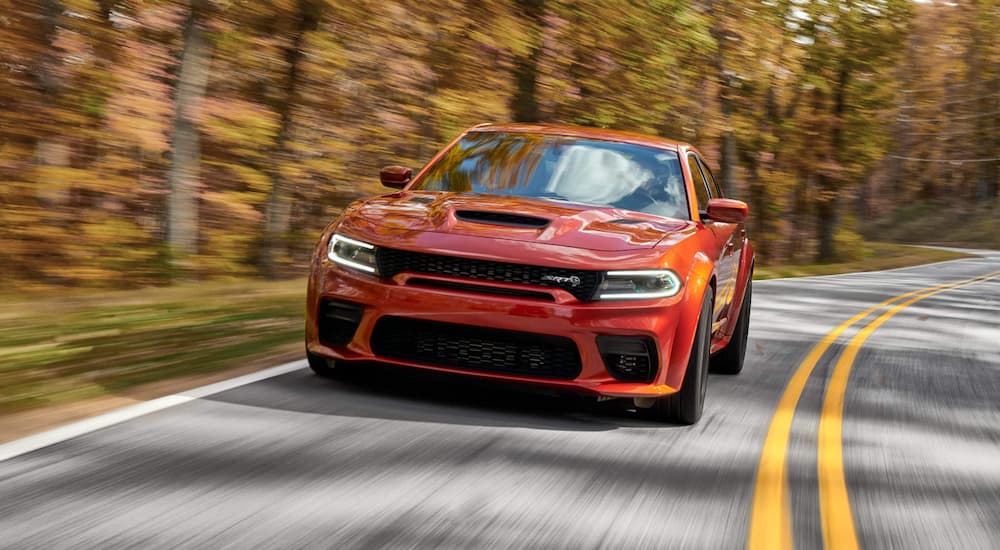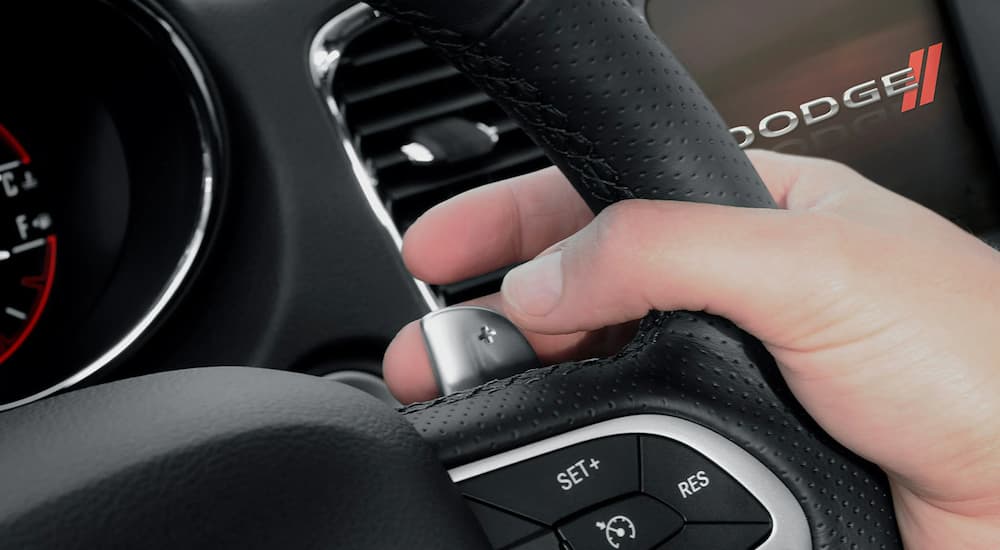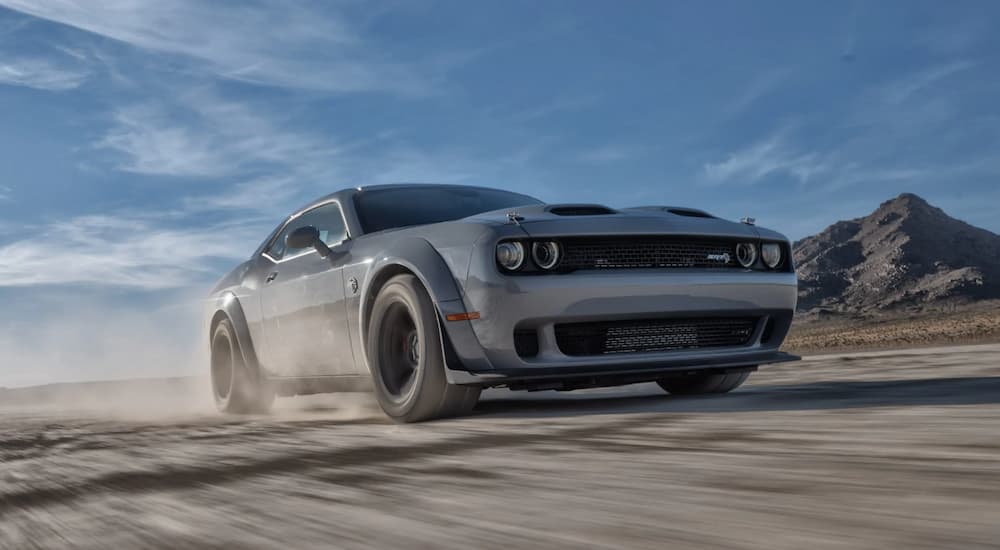Check Out Our Youtube Channel! Click Here

Do you want an all-American muscle car? Something that looks mean, has a great profile, puts down lots of power, and gives you the sort of exhilaration and excitement on the road you just won’t find from any other vehicle? Then hands down, you’re going to be eyeing two of the most popular (and two of the last remaining) muscle cars on the market today: the Dodge Charger and the Dodge Challenger. But as you prepare yourself to make a purchase, you’re likely asking, “When I visit a Dodge dealer near me, should I get a Challenger or a Charger?”
It’s an age-old question that dates back decades when it comes time to pick between two similar vehicles from the same brand. They’re both power-hungry cars that burn rubber and are known for their iconic HEMI V8 engines. But which one is right for you? And if given the opportunity, which one should you buy? We’re here to help you iron out a game plan so you know which one to buy and why. This way, when it’s time to visit us at Spirit CDJR, you’ll know exactly which car suits your budget and your rubber-burning desires. So let’s get started with the basics.

Two-Door vs Four-Door
If you’re unfamiliar with the Dodge Charger and Dodge Challenger, the most obvious difference between the two vehicles is that one is a sports coupe, and the other is a sports sedan. The Challenger is a two-door notchback, while the Charger is an almost full-size four-door sedan. This makes a decided difference in terms of size, cabin volume, and cargo capacity. It also impacts the performance of the two cars, as the Challenger lives up to its sportier looks.
Now, just because the Challenger is a two-door coupe doesn’t mean that the seating arrangements are limited to just two people. In fact, the Challenger actually seats up to five people across two rows. There are even 94 cu.ft. of passenger space and 33.1 inches of rear legroom. Given its size, the Challenger could be a family vehicle, but it wouldn’t make for the most practical family vehicle even if you have small kids who don’t mind sitting in the back. While it can fit up to five people, the Challenger was built for speed.
The Charger also seats up to five people across two rows. However, it comes in a four-door configuration. Unlike the Challenger, the Charger is designed to be more convenient for families with its four doors and larger passenger volume. Thanks to the more spacious cabin, you can comfortably fit a couple of kids and a pet inside. You get a total passenger volume of 105 cu.ft. with an impressive 40.1 inches of rear legroom.
Additionally, both vehicles offer some impressive trunk space, with the Charger’s trunk capacity clocking in at 16.5 cu.ft. of space and the Challenger’s being only slightly smaller at 16.2 cu.ft. of space. You won’t have any problems storing goods in either vehicle. However, you do get more interior options with the Challenger.
Both cars have several different interior color choices available, including Black, Caramel, Ruby Red, Sepia, Hammerhead Gray, and Demonic Red. But the Challenger has both Sport Seats and Performance Seats available in well over a dozen different options, including a variety of materials from Houndstooth cloth to Laguna leather and Alcantara. If interior customization is high on your wishlist for a vehicle, then the Challenger and Charger offer it up in spades.
Rear-Wheel Drive vs All-Wheel Drive
Are you wondering, “Should I go with a rear-wheel drive or all-wheel drive car?” Then you will be pleased to know that both the Dodge Charger and Dodge Challenger are available in rear-wheel drive or all-wheel drive. Both vehicles offer all-wheel drive with their SXT and GT trims, although every other trim is rear-wheel drive only. Where the two cars differ is in performance. Both offer Pentastar V6 and HEMI V8 powertrains, but you get more performance out of the Challenger compared to the Charger.
While the horsepower and torque are very similar between the two, the entry-level Charger tops out at 292 hp with a Pentastar V6, while the base Challenger has 303 hp from the same engine. Further, the Charger is a larger vehicle with more weight to move around and more passenger volume, which comes at the expense of peak performance. So obviously, you can obtain slightly better performance in the Challenger if that’s what you’re gunning for.
However, both vehicles offer a wide range of powertrain options beyond the Pentastar V6, including a 5.7L HEMI V8, a HEMI 392 V8, a supercharged Hellcat V8, and a High-Output Hellcat V8. Which trim you choose will determine which engine is paired with the vehicle and how much performance you can get out of it. If you want a rear-wheel drive vehicle that’s all about maximum power, you can get it from either the Charger or the Challenger. Alternatively, if you want an all-wheel drive option for better traction and stability, you can take advantage of that from both vehicles as well.

Jailbreak vs SRT Super Stock
When it comes to the trim selection, the newer Charger and Challenger model years offer many of the same trims. The SXT, GT, R/T, Scat Pack, Scat Pack Widebody, SRT Hellcat Redeye Widebody, and Jailbreak are shared between both vehicles. But keeping with the theme of performance, the Challenger is available in SRT Hellcat and SRT Hellcat Redeye trims with or without the widebody modification. It’s something to consider depending on which trim speaks to you most.
However, the biggest divergence between the two vehicles comes in the form of the top-end trims. For the Charger, the top trim available is the Jailbreak, which comes with the 6.2-liter High-Output Hellcat V8. It produces 797 hp and 707 lb-ft of torque, making it an absolute monster. The Challenger is also available in the Jailbreak trim, but its version tops out at 807 hp and 707 lb-ft of torque, just edging out the Charger in terms of performance.
Alternatively, the Challenger also has the SRT Super Stock as its top trim (previous model years offered the now legendary Demon, but sadly it’s no longer available). This trim is designed for drag racing, much like the Demon, allowing the Challenger to hit 0 to 60 mph in just 3.25 seconds, making it even faster than the Challenger Jailbreak. It also comes standard with Nitto NT05R Drag Radial Tires. Unfortunately, the Super Stock is not available for the Charger. So there is a difference in the top-end performance capabilities between the two vehicles, with the availability of certain trims like the Super Stock being exclusive to the Challenger.
Price vs Convenience
Whether you decide to go with the Challenger or Charger depends on your budget, driving preferences, and what you feel is most convenient to own. If you have a family, then the Charger is probably going to be the better choice. If you’re on a budget and it’s just you, the Challenger GT and R/T are the more affordable options, both with a starting MSRP that’s under $40,000. In fact, the Challenger R/T starts at $39,075, whereas the Charger R/T starts at $41,405.[a]
If you need the space and cabin volume, the Charger will be your better bet. If you want maximum power, then the Challenger is the better option. Both have a unique set of exterior colors, but you definitely get a more varied interior selection with the Challenger if that’s something that might persuade you in your purchasing decision. So now, if you’re thinking, “Which high-performance Dodge muscle car should I get?” you have a better idea of what each one offers. Hopefully, it will make it easier when it’s time to settle on a purchase.
[a]MSRP subject to change. Please see dealer for details.








